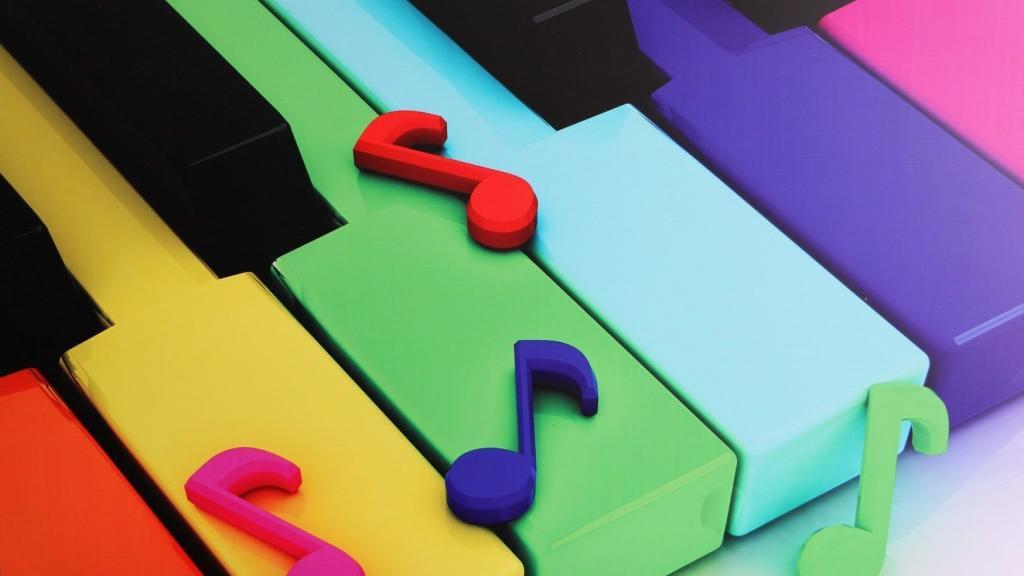Last Updated on July 10, 2022 by Rebecca
Disclosure: Please note that this article contains affiliate links, and that means that I may earn a commission if you buy something through my links. Read my full disclaimer here.
One of the very first things you'll need to learn about the piano is the layout of the keys. You need to learn where the piano keys are, what they are called, and how to instantly find them by name.
So, let's jump right in and start getting to know the piano keys!
How many keys are there on a piano?
A full-sized piano has 88 keys. Of those keys, 52 are white, and 36 are black. (You can count them if you don't believe me!) The keys on the piano are collectively called the keyboard.

Electric keyboards are also available in smaller sizes, some with 76, 61, or 49 keys.
The main reason the keys are arranged in black and white keys (instead of just a huge row of identical white keys) is to help us find the specific keys we need at any given time.
This post will focus on learning the white keys. (I'll write a separate post later about the black keys.)
Pitch and Orientation
A quick note about orienting yourself with the keyboard:
The keys to the far left are the low keys, which create low-pitched sounds. For this reason, we call this the bottom of the keyboard.
The keys to the far right are the high keys, which create high-pitched sounds. For this reason, we call this the top of the keyboard.
When you move from left to right, you are moving up the keyboard.
When you move from right to left, you are moving down the keyboard.

The Music Alphabet
The music alphabet consists of only 7 letters: A, B, C, D, E, F, and G. (Although, apparently, in some countries there is an H, but we won't get into that.)
When you get to the end of the music alphabet, you just start back at A and keep going.
So if we colour-coded the piano keyboard by letter name, it would look like this:

We'll break it down into individual keys, but first, I want to address one very important issue.
When you're learning the keys on the piano, it is CRUCIAL that you recognize each key in its own right. This means you don't just learn where C is and then figure out where F is by counting from C.
I can't stress this enough.
Obviously, counting from C would work, but it's a huge waste of time.
Take a look at the numbers below, and find the number 4 for me:
1 2 3 4 5 6 7 8 9 10
I bet you found it pretty quickly, didn't you?
And I bet you didn't start at 1 and count your way up one number at a time, did you?
I bet you think starting at 1 and counting up one number at a time would have been a ridiculous strategy and a waste of your time, don't you?
I'd be willing put money down that what you did do, was immediately jump to the spot just left of the middle, because you knew that's exactly where the 4 would be.
And I bet when your eyes landed on the 4, you knew instantly what what you were looking at was, in fact, a 4. Absolute confidence, no second-guessing whatsoever.
That's how it should be with piano!
You want to know exactly where to look to find an F, and you want to know exactly what an F looks like, without any doubts.
You don't want to have to start at C and count your way up every time. Because doing that would be a ridiculous waste of your time. You're smarter than that.
So let's take a look at the keys now.

Patterns of Black Keys
The black keys are arranged in an alternating pattern of groups of 2 and 3.

If you follow the pattern, you know that the lonely black key at the bottom is the first key of what would have been a group of 3 black keys, if the keyboard didn't end.
Groups of 2 Black Keys

The white key immediately to the left of any group of 2 black keys will always be C.
The white key inside any group of 2 black keys will always be D.
The white key immediately to the right of any group of 2 black keys will always be E.
Groups of 3 Black Keys

Outside Keys:
The white key immediately to the left of any group of 3 black keys will always be F.
The white key immediately to the right of any group of 3 black keys will always be B.

Inside Keys:
The white key on the inside left of any group of 3 black keys will always be G.
The white key on the inside right of any group of 3 black keys will always be A.
Why didn't I teach you the keys in order?
Because I don't want you to learn them in order!
Remember, you need to recognize each key on its own,
without counting from C every time.

Now let's take a look at how everything we've just learned about piano keys and the music alphabet applies to the full keyboard.
The A Keys
To find an A key, look for any group of 3 black keys, and find the white key on the inside right.

*We know the very bottom key is an A because based on the pattern of groups of 2 and 3 black keys, that lonely black key is part of what would have been a group of 3 black keys, if the keyboard didn't end.
The B Keys
To find a B key, look for the white key to the right of any group of 3 black keys.

The C Keys
To find a C key, look for the white key to the left of any group of 2 black keys.

*We know the very top key is a C because based on the pattern of groups of 2 and 3 black keys, the next keys would have been a group of 2 black keys, if the keyboard didn't end.
The D Keys
To find a D key, look for the white key inside any group of 2 black keys.

The E Keys
To find an E key, look for the white key to the right of any group of 2 black keys.

The F Keys
To find an F key, look for the white key to the left of any group of 3 black keys.

The G Keys
To find a G key, look for a group of 3 black keys and find the white key on the inside left.

Want a quick and easy 1-page cheat sheet to help you learn all the piano keys?
To make life super easy for you, I've created a 1-page cheat sheet that you can download and print to help you learn all the keys on the piano.
Want a handy resource to help you memorize all the keys?
This blog post will explain why piano key sticker labels are the devil (not literally!), and offers a set of free flash cards you can use instead to experience greater success!
Related Posts
- Learn to Read Piano Notes: A Beginner's Guide to Reading Sheet Music
- How to Build Any Piano Triad… in Seconds! [An Illustrated Guide]
- Piano Buying Guide: How to Choose the Right Piano for YOU!
- Will Piano Key Stickers Help Me Learn to Play Piano?
You might also appreciate my FREE online piano course, Confused Beginner to Confident, Creative Piano Learner.





I love this post! I took lessons as a child but stopped before I really developed the talent. But I have always wanted to learn since I became an adult. I even tried teaching myself for a while but I couldn’t catch on. I love the way you said to learn each key by sight instead of starting with “C” and counting over. That is exactly where I was going wrong! You’ve inspired me to pull out my keyboard again, thanks!!
Hi DeShena! I’m so happy to hear I’ve inspired you and helped you experience an A-HA moment in your piano journey. Things really do fall into place a lot more easily once you are able to recognize each key on sight. And if you want to really speed that along, I’ve got some handy flash cards coming up with my next blog post! 😉 If you do pull out your keyboard and give it another go, reach out and let me know how it goes! I would love to hear about your experience and help you out if I can!
Thank you for this post. I really have been looking for a chart like this to help me learn to play. You explained it so clearly. I am just at the beginning of my piano lesson journey.
Hi Becca, Glad I could help! I hope you’ll have a lot of fun with your piano journey! 🙂
Very interesting. I have never realized all this about the piano. I have always wanted to learn and have thought I would really enjoy it, cos though I have no talent I like the piano. So this is a great preliminary introduction into the piano. I may just get inspired to start learning. Love the way you broke it all down.
Hi Jane! So glad I sparked some inspiration in you! I publish new posts every 2 weeks, so if you think you might be interested in learning, check back every now and then for more piano information. The truth is, you don’t need talent to learn piano. You just need to be interested and willing to practice. If you like it enough to spend time doing it, you will be able to do it! 🙂
You are a wonderful teacher! I had piano lessons as a child. Then took lessons again as an adult. I love your methods.
Interestingly, while taking lessons as an adult I was pregnant with my son. He began playing piano when he was two and plays beautifully! I believe he heard me practicing and playing all through the pregnancy.
Thanks so much for the positive feedback, Cindy! Are you still taking adult lessons? What kind of music do you enjoy playing?
Sounds like you found a very sneaky way to encourage a love and talent for piano in your son, haha! Maybe I will try the same thing when the time comes for me! 😉
Oh my Rebecca! That was a very clean and straightforward way to teach beginners to play the piano. I have played the piano since I was little and went to piano school for 6 years. My family are all pianists. However, I didn’t have the passion for it. I just played because everyone did. Now, my little guy is turning 4 and I want him to learn how to play the piano. It is a very beautiful skill to learn and I regret not loving it the first time. I still can play, but I am very rusty. Keep doing what you are doing! You are awesome!
Thanks for the positive feedback, Donna! Best of luck with your little boy. I hope he ends up loving piano! (Or finding something else he loves!) Did you ever try improvising when you learned the first time? If not, that might be something worth exploring now if you’re interested in trying again. It’s a great way to have fun with the piano in a relaxing and stress-free way!